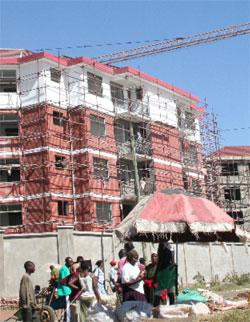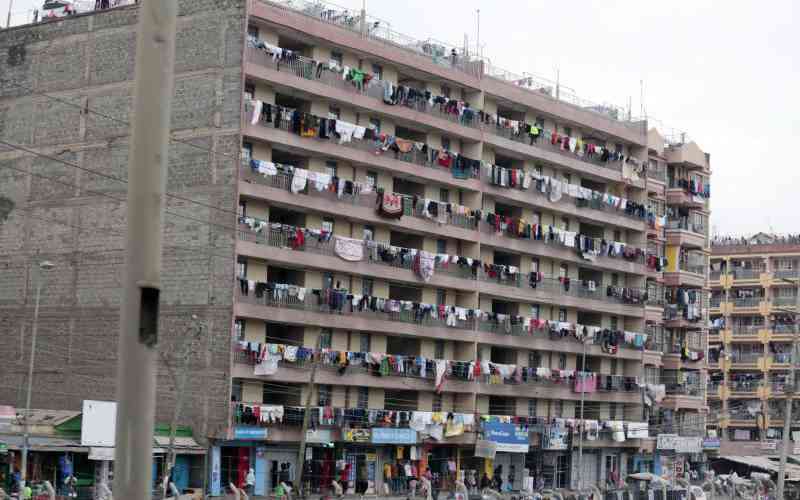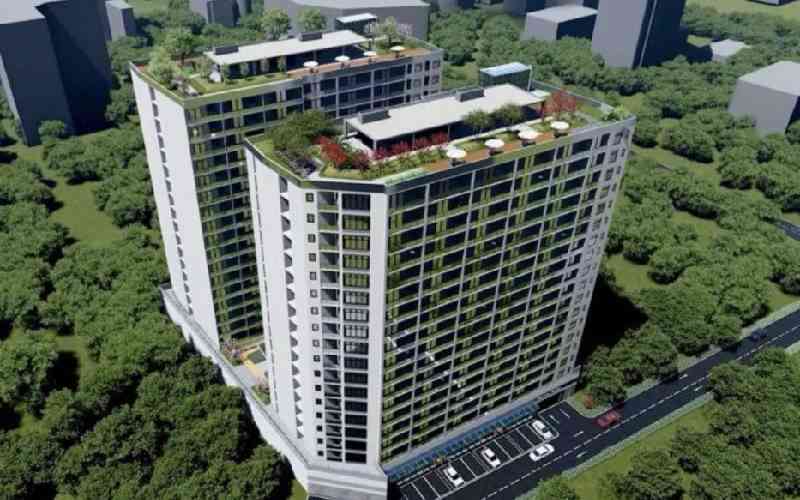By Peter Wasilwa
With the high rate of urbanisation in Kenya, it is estimated that in another 20 years, the urban population will have grown to 70 per cent from the current 30 per cent. This means the relevant infrastructure must also expand to match this huge growth. Our land use policy should also be changed to allow for high-density settlements both in urban and rural areas.
It is obvious, though, that we do not have that much land and our towns cannot continue growing forever. One of the challenges that urgently needs to be addressed, therefore, is the large chunks of land, which must be cleared to pave way for housing. We do not have to clear any more of our scarce forests to pave way for more housing.
 |
Apartments under construction. High-density settlements make it possible to concentrate quality leisure facilities like swimming pools and sports clubs. Photos: File/Standard |
High-density areas are easier to service. The cost of providing infrastructure services such as electricity, water and sewage disposal progressively reduces as more and more homes are served by a kilometre of pipeline. The same applies to the distribution of food and other goods. These can easily be distributed to large concentration of population.
Perhaps the most significant economic benefit is the more efficient transport systems, which can be developed in high-density areas. It is good that places like Lavington, Kileleshwa, Westlands and Parklands in Nairobi have been zoned for high-density settlements. Unfortunately, the approved plot coverage ratios and the four-storey skylines are grossly inadequate.
Social cohesion
Currently, an acre of prime land in Lavington goes for about Sh100 million. This cost makes it so difficult for developers to recoup their investment without flouting coverage ratios and overcharging prospective buyers. These developers should be encouraged to build higher apartment blocks to save on scarce land and the local authorities can make this possible by improving infrastructure.
High-density housing with an efficient transport and distribution network uses less energy. When we reduce our energy consumption, we cause less pollution by reducing carbon dioxide emission. People who live in closely knit, high-density neighbourhoods will travel for less distances on a daily basis since their work places will most likely be near where they stay. Important social amenities will also be within a walking distance.
To further reduce the need to cover long distances to work, we need to embrace technology. Many people should be encouraged to work from home or their local cafÈs and submit their work online. High density settlements will make it possible to have quality leisure facilities like cinemas, restaurants, sports clubs and swimming pools among others. This can be a chance for the Kenyan people to build cohesive multi-ethnic communities.
In the rural areas, high-density settlements will not only enable the much needed social cohesion but will also free many acres of the much needed agricultural land and make it easier to provide services like security, water and electricity.
Review standards
A sustainable high-density settlement goes beyond many people sharing a small area of land but must afford privacy and comfort and trigger pride and a sense of ownership. However, most of our multi-storey estates have defied all perceivable regulations leading to the general deterioration and stigmatisation of flats. Standards for flats need to be reviewed and regulations vigorously enforced.
The writer is a registered architect
Stay informed. Subscribe to our newsletter
 The Standard Group Plc is a
multi-media organization with investments in media platforms spanning newspaper
print operations, television, radio broadcasting, digital and online services. The
Standard Group is recognized as a leading multi-media house in Kenya with a key
influence in matters of national and international interest.
The Standard Group Plc is a
multi-media organization with investments in media platforms spanning newspaper
print operations, television, radio broadcasting, digital and online services. The
Standard Group is recognized as a leading multi-media house in Kenya with a key
influence in matters of national and international interest.
 The Standard Group Plc is a
multi-media organization with investments in media platforms spanning newspaper
print operations, television, radio broadcasting, digital and online services. The
Standard Group is recognized as a leading multi-media house in Kenya with a key
influence in matters of national and international interest.
The Standard Group Plc is a
multi-media organization with investments in media platforms spanning newspaper
print operations, television, radio broadcasting, digital and online services. The
Standard Group is recognized as a leading multi-media house in Kenya with a key
influence in matters of national and international interest.










